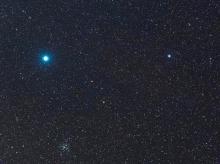Listen to today's episode of StarDate on the web the same day it airs in high-quality streaming audio without any extra ads or announcements. Choose a $8 one-month pass, or listen every day for a year for just $30.
You are here
Bright Dog
The big dog ambles across the southern sky on winter evenings. It’s easy to spot because its brightest star is the Dog Star, Sirius — the brightest star in the entire night sky.
But Canis Major has many stars that are even more impressive than Sirius — stars that look fainter only because they’re much farther away.
An example is Adhara, which represents one of the dog’s hind legs. It’s below Sirius as night falls. To the eye alone, it looks only a fraction as bright as Sirius. But if you could see it from the same distance as Sirius — less than nine light-years — Adhara would look about 200 times brighter than Sirius.
That’s because Adhara is both a good bit bigger than Sirius and a good bit hotter. It’s so hot that it radiates most of its energy as ultraviolet light. When you add up all the forms of energy it produces, Adhara probably is more than 30,000 times brighter than the Sun.
The star is also much heavier than the Sun. That greater heft means the star will live only a fraction as long as the Sun will. In fact, it’s already entering the final stages of life. A series of complex changes in its core will cause it to puff up like a balloon, getting much brighter as it does so.
Eventually, Adhara will explode as a supernova. That will send its outer layers racing through the galaxy at a few percent of the speed of light. Only the star’s dead core will remain — a tiny remnant of a once-mighty star.
Script by Damond Benningfield




